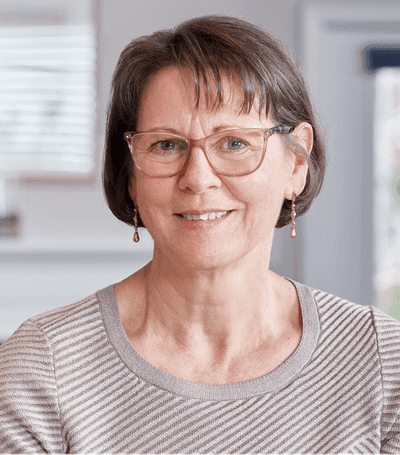WHEN ADULTS WITH MAC LUNG DISEASE REMAINED CULTURE POSITIVE AFTER ≥6 MONTHS OF MULTIDRUG THERAPY,*
ARIKAYCE helped patients get converted and stay converted1-3
Negative culture conversion results lasted for up to 15+ months
Of patients who remained on therapy for 12 months after culture conversion, only those on ARIKAYCE + multidrug therapy stayed culture negative after all treatment ended.1,3
In the CONVERT trial, the endpoints of the change from baseline in 6MWT distance and SGRQ did not demonstrate clinical benefit at Month 6.1
In the CONVERT trial, the endpoints of the change from baseline in 6MWT distance and SGRQ did not demonstrate clinical benefit at Month 6.1
CONVERT study design
The efficacy and safety of ARIKAYCE + multidrug therapy vs multidrug therapy alone were evaluated in an open-label, randomized (2:1), multicenter, global, Phase 3 trial of 336 adult patients with refractory MAC lung disease.1,2
Primary endpoint1,2
Patients who culture converted by Month 6. Patients needed to achieve their first negative culture by Month 4 to meet the primary endpoint. Culture conversion was defined as 3 consecutive monthly negative sputum cultures. The study design required 2 or 3 negative sputum samples per month for 3 consecutive months to confirm culture conversion.
Secondary endpoints/responder analysis2,3
Patients who remained culture converted 12 months after initial conversion, and 3 and 12 months after treatment ended, along with change from baseline in 6MWT and SGRQ.
See how adding ARIKAYCE helped real patients get converted and stay converted1-3
Individual results may vary.
Real patients have been compensated for their time.
**Real patient data current as of October 2023.
††Real patient data current as of August 2022.
‡‡Real patient data current as of July 2024.
WHEN ADULTS WITH MAC LUNG DISEASE REMAIN CULTURE POSITIVE AFTER ≥6 MONTHS OF MULTIDRUG THERAPY,
NTM Treatment Guidelines strongly recommend the addition of ARIKAYCE1,6
MAC lung disease diagnosed: Start multidrug therapy6
The Guidelines recommend treatment initiation rather than watchful waiting. Initiate a 3-drug regimen of azithromycin, ethambutol, and rifampicin, especially for those with positive AFB sputum smears and/or cavitary lung disease.After treatment initiation: Obtain sputum cultures every 1 to 2 months during treatment6
If still culture positive after ≥6 months of multidrug therapy: Add ARIKAYCE6
Guidelines strongly recommend adding ARIKAYCE if patients remain culture positive after ≥6 months of multidrug therapy.
Keep patients on therapy6
Guidelines recommend continuing MAC treatment for 12 months after culture conversion.#
6MWT=6-minute walk test; AFB=acid-fast bacilli; ATS=American Thoracic Society; COPD=chronic obstructive pulmonary disease; CT=computed tomography; HIV=human immunodeficiency virus; ID=infectious disease; IDSA=Infectious Diseases Society of America; ITT=intent to treat; MIC=minimum inhibitory concentration; NTM=nontuberculous mycobacteria; SGRQ=St George's Respiratory Questionnaire.
1. ARIKAYCE [package insert]. Bridgewater, NJ: Insmed Incorporated; 2023. 2. Griffith DE, Eagle G, Thomson R, et al; CONVERT Study Group. Amikacin liposome inhalation suspension for treatment-refractory lung disease caused by Mycobacterium avium complex (CONVERT): a prospective, open-label, randomized study. Am J Respir Crit Care Med. 2018;198(12):1559-1569. doi:10.1164/rccm.201807-1318OC 3. Griffith DE, Thomson R, Flume PA, et al; CONVERT Study group. Amikacin liposome inhalation suspension for refractory Mycobacterium avium complex lung disease: sustainability and durability of culture conversion and safety of long-term exposure. Chest. 2021;160(3):831-842. doi:10.1016/j.chest.2021.03.070 4. Griffith DE, Eagle G, Thomson R, et al; CONVERT Study Group. Amikacin liposome inhalation suspension for treatment-refractory lung disease caused by Mycobacterium avium complex. Online data supplement. Am J Respir Crit Care Med. 2018;198(12)(suppl):E1-E28. Accessed June 21, 2024. https://www.atsjournals.org/doi/suppl/10.1164/rccm.201807-1318OC/suppl_file/griffith_data_supplement.pdf 5. Data on file. Insmed Incorporated. Bridgewater, NJ. 6. Daley CL, Iaccarino JM, Lange C, et al. Treatment of nontuberculous mycobacterial pulmonary disease: an official ATS/ERS/ESCMID/IDSA clinical practice guideline. Clin Infect Dis. 2020;71(4):e1-e36. doi:10.1093/cid/ciaa241 7. Griffith DE, Aksamit T, Brown-Elliott BA, et al; ATS Mycobacterial Diseases Subcommittee. An official ATS/IDSA statement: diagnosis, treatment, and prevention of nontuberculous mycobacterial diseases. Am J Respir Crit Care Med. 2007;175(4):367-416. doi:10.1164/rccm.200604-571ST











